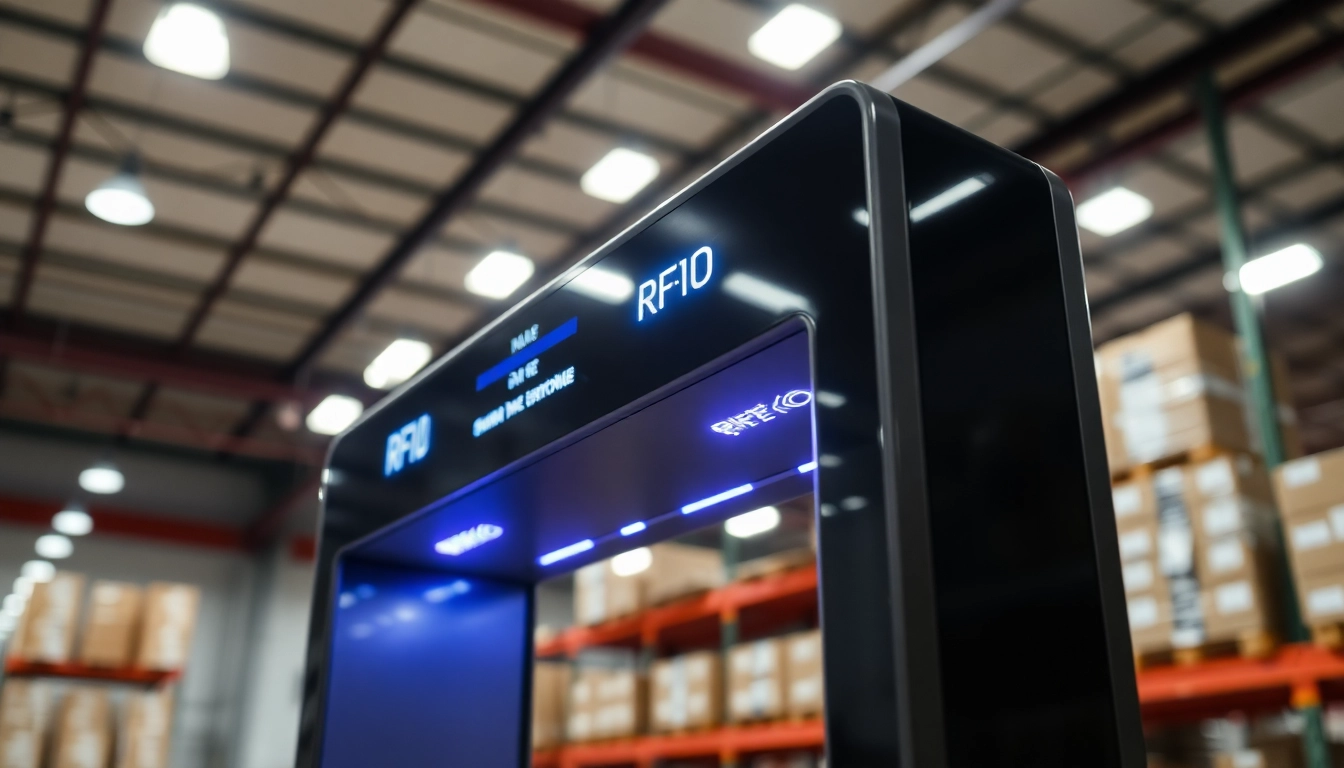Understanding RFID Portals
What is an RFID Portal?
RFID portals, also referred to as RFID gates or readers, are integrated systems designed to read Radio Frequency Identification (RFID) tags as they pass through a specific area. These portals typically consist of antennas and embedded transceivers that create a “read zone” capable of detecting RFID tags in motion. The primary function of an RFID portal is to automate the process of inventory tracking and asset management, significantly enhancing operational efficiency and accuracy in various sectors, including manufacturing, logistics, and retail. By understanding what an RFID portal is, businesses can leverage this technology to streamline their operations and improve data management.
The Technology Behind RFID Portals
The foundation of RFID portals lies in the technology that enables communication between RFID tags and the reader system. RFID tags contain microchips and antennas that emit signals. When an RFID tag enters the read zone of a portal, the antenna on the portal emits a radio frequency signal that activates the tag, prompting it to send back its unique identification number to the transceiver. The transceiver processes this data and transmits it to a connected system for further processing and integration into inventory management solutions.
RFID technology operates on various frequency bands—low frequency (LF), high frequency (HF), and ultra-high frequency (UHF)—each serving specific applications. UHF RFID portals are particularly popular due to their ability to read multiple tags simultaneously over a larger distance, making them suitable for high-traffic environments such as warehouses and retail stores.
Benefits of Using RFID Portals
Investing in RFID portal technology offers numerous advantages:
- Enhanced Inventory Accuracy: RFID portals significantly reduce human error in inventory management by automating the tagging and tracking process, leading to higher accuracy levels.
- Increased Efficiency: The ability to read multiple tags quickly enables faster processing times at checkpoints or loading docks, thereby improving overall operational efficiency.
- Real-Time Data: RFID portals provide instant data capture that can be integrated with inventory management systems, giving businesses real-time visibility into stock levels and asset locations.
- Improved Security: With accurate tracking and monitoring capabilities, RFID portals can help prevent theft and loss, enhancing security measures for valuable assets.
- Cost Savings: Over time, the efficiency gained from RFID portals can lead to significant cost reductions related to labor, management, and loss prevention.
Choosing the Right RFID Portal for Your Business
Factors to Consider When Selecting an RFID Portal
When selecting an RFID portal, businesses must consider several key factors to ensure it meets their specific needs:
- Read Range: The read range will influence the design of the installation area and the number of portals required to achieve effective coverage.
- Tag Compatibility: Ensure that the RFID portal is compatible with the types of RFID tags you plan to use (LF, HF, UHF).
- Environment: Consider the operational environment (e.g., indoor vs. outdoor, temperature, and humidity) as it could impact the portal’s performance.
- Integration Capabilities: The RFID portal should seamlessly integrate with existing hardware and software systems to provide a cohesive inventory management solution.
- Cost and ROI: Evaluate the initial cost of acquisition against potential returns through improved efficiency and accuracy.
Comparing Different RFID Portal Models
As the market for RFID portals grows, so does the variety of models available. Businesses should compare different models based on specific use cases. Some notable options include:
- Zebra Integrated RFID Portals: Known for their high reliability and advanced integration capabilities, these portals are well-suited for complex operations that require robust inventory systems.
- Atlas RFID Store Portals: Offer a range of reader options designed for various environments, focusing on user-friendliness and ease of installation.
- RFID4USTORE Solutions: Specialize in entrances and gates, providing modular systems that can be tailored to specific monitoring needs.
Cost Considerations for RFID Portals
The initial cost of RFID portals can be significant; however, businesses must view this as a long-term investment. Here are some financial aspects to consider:
- Initial Setup Costs: This includes purchasing the RFID portal hardware, installation charges, and any necessary infrastructure upgrades.
- Maintenance and Support: Factor in ongoing maintenance costs and potential software licensing fees for the system.
- Operational Savings: Analyze the potential savings in labor, loss prevention, and enhanced inventory management when calculating ROI.
Implementing RFID Portal Solutions
Steps to Install RFID Portals in Your Facility
Implementing RFID portals involves careful planning and execution. Here’s a structured approach:
- Needs Assessment: Identify your specific needs for RFID technology within your operations. Understanding your goals will help determine the best system configuration.
- Select Hardware: Choose the appropriate RFID portal and accompanying hardware based on the factors detailed previously.
- Design the Layout: Plan the physical layout of the portals to ensure optimal coverage and minimal interference. This should include identifying entry and exit points and any potential obstacles.
- Installation: Follow the manufacturer’s guidelines for installation. Ensure that all components, such as antennas and transceivers, are correctly positioned.
- Testing: After installation, conduct thorough testing to confirm that the system works correctly in real-world situations. Adjustments may be necessary based on performance metrics.
Integrating RFID Portals with Existing Systems
Successful integration of RFID portals with existing inventory management systems is crucial for maximizing their effectiveness. Key considerations include:
- Compatibility: Ensure that the RFID system can connect with existing software platforms through APIs or middleware solutions.
- Data Synchronization: Implement processes to ensure real-time data synchronization between the RFID portals and central databases.
- Training and Support: Provide training for staff on the new system and establish support channels for troubleshooting integration issues.
Training Staff to Use RFID Portals Effectively
To fully realize the benefits of RFID portal technology, training staff is essential. Key training components should include:
- System Navigation: Teach employees how to navigate and interpret the data generated by the RFID portals.
- Problem Solving: Train staff on common issues they may encounter and provide them with troubleshooting steps.
- Data Management: Encourage best practices for data entry, management, and reporting from the RFID system.
Best Practices for Using RFID Portals
Maximizing Efficiency with RFID Portals
To maximize the efficiency of RFID portal systems, consider the following best practices:
- Regular Maintenance: Schedule routine maintenance checks to ensure optimal performance and identify potential issues before they escalate.
- Data Utilization: Analyze the data collected through RFID portals for actionable insights that can drive decision-making and process improvements.
- Continuous Training: Keep staff updated on system changes and enhancements through ongoing training sessions focused on emerging practices and technologies.
Common Challenges and How to Overcome Them
While RFID portal implementation brings numerous benefits, businesses may face challenges such as:
- Interference Issues: Physical obstructions or environmental factors can interfere with the reading capability of RFID portals. Adjusting antenna positions and scanning angles can mitigate these issues.
- Data Overload: With real-time data collection comes the risk of overwhelming systems with excessive information. Implement data management strategies to filter and prioritize actionable data.
- Staff Resistance: Employees may resist adopting new technology. Effective change management and clear communication about the benefits of RFID systems can help ease this transition.
Case Studies of Successful RFID Portal Implementations
Examining real-world examples of successful RFID portal implementations can provide valuable insights:
- Case Study 1: A large retail chain implemented RFID portals at store entrances, resulting in a 30% reduction in stock discrepancies and improved customer satisfaction through better inventory accuracy.
- Case Study 2: A logistics company introduced RFID portals at their distribution centers, enhancing real-time tracking of shipments and streamlining operation processes, which led to a 25% decrease in delivery times.
The Future of RFID Portals in Industry
Emerging Trends in RFID Technology
The RFID industry is rapidly evolving, with trends such as:
- Internet of Things (IoT) Integration: RFID technology is increasingly being combined with IoT devices, providing enhanced data analytics and connectivity for real-time monitoring and management.
- Cloud-Based Solutions: Cloud computing is facilitating easier data storage and access, allowing for scalable RFID solutions tailored to businesses of all sizes.
- Advanced Analytics: The integration of AI and machine learning in RFID systems enables predictive analytics, further informing inventory management practices and operational efficiencies.
The Role of RFID Portals in Automation
RFID portals play a crucial role in the automation of processes across industries, as they offer:
- Automated Inventory Management: By automating data capture and entry processes, RFID portals reduce the need for manual inventory checks.
- Enhanced Workflow Efficiency: Inventory tracking becomes seamless, facilitating quicker turnover rates and access to essential data.
- Cost Reduction: Automation can lead to lower operational costs, as businesses can allocate their resources more effectively.
Preparing for the Next Generation of RFID Solutions
As RFID technology advances, businesses should proactively prepare for new developments, including:
- Upgrading Hardware: Stay informed on the latest technologies and consider upgrading to next-generation RFID portals as they become available.
- Training for New Technologies: Continuous staff training on emerging RFID technologies will ensure that your team is equipped to utilize the latest tools effectively.
- Investment in Research: Allocate resources to research and development initiatives aimed at enhancing RFID applications in your organization.



